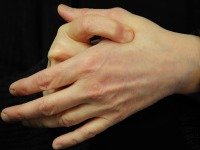Learn How to Use the Hoku Point
for Pain Relief
The Hoku point, widely used in acupuncture and acupressure to relieve pain, is located on the hand.
Acupuncture and acupressure are key techniques of Traditional Chinese
Medicine. In Traditional Chinese Medicine, illness and pain are seen as
the result of interrupted/imbalanced flow of qi (energy). While acupuncture uses needles and requires years of training, acupressure, as the name suggests, uses pressure, usually applied with your hands. Almost everyone is capable of learning basic acupressure technique and a few important acupressure points.
Acupressure/acupuncture points are places where the flow of qi
can be influenced to regulate body functions in addition to relieving
pain. Various points on the body are used to address various issues. As with acupuncture, the
aim of acupressure is to restore and balance the flow of qi through the
body.
The Hoku point is a highly useful point both because of it helps with many issues, and because it is easy to locate and press.

Finding and Using the Hoku Point
The “Hoku point” is also called LI4 because it is the 4th point on the Large Intestine meridian. Acupuncture meridians are subtle energy pathways in the body. Traditional Chinese medicine (TCM) has for many centuries studied and worked therapeutically with these energy channels. The body’s vital energies (called “qi” or“chi” in TCM) flow continuously through these pathways -- kind of like blood through our blood vessels -- nourishing, maintaining and restoring all the body’s organ systems. If the flow of qi is imbalanced or interrupted, illness and pain can result.
The Hoku point is good for relieving many kinds of pain as
well as other discomforts. It can help relieve headaches, as well as joint and muscle pain
anywhere in the body. It's also good for soothing and calming, and for
letting grief move through you (instead of getting stuck).
The Hoku point is located on the back of the hand, in the webbing between the thumb and index finger. Find the exact point by closing the gap between your thumb and index finger, so that they are touching, side by side. The muscle will bulge a little--that's the spot.
If that isn't clear, you can also just relax your hand back into a neutral position, and with the index finger of the other hand, follow the webbing between your thumb and index finger (the soft gap or "valley" that lies between the bones that lead to your thumb and index finger) to the place where these two bones intersect. Then back off a little bit so that your finger is pressing into just soft tissue, no boney feel. Don't worry about being overly precise--the tip of your index finger is big enough that it's going to be hitting the correct point.
Squeeze LI4 by putting your thumb on the point, and your index finger on the palm side of your hand--or vice versa, whichever works best for you. You can hold this a minute or so, or until you feel a shift in your energy and/or you feel relief. You should press firmly but not so that it hurts.

I offer The Energy Healing Site free of charge and without external ads. If you'd like to support me in my work to make energy healing more accessible to a broader range of people, you can purchase my book, Chakra Care: Do-It-Yourself Energy Healing for a More Joyful, Loving, Fruitful Life. You'll learn
to clear, nurture and support your own chakras with 500 fun, down-to-earth
activities. A user-friendly, practical guide that teaches about energy and energy healing as well, it available as a paperback
or Kindle.
Michael Reed Gach in his book Acupressure's Potent Points recommends that while you are pressing the Hoku spot, you also move the joint nearest the part of your body that's in pain. For example, if your upper calf is in pain, you would bend and unbend your knee. Acupressure's Potent Points is a great book, by the way, very user friendly.
Including breathwork along with the acupressure is always a good
thing. You can just deepen and slow your breath as you hold the point,
or you can follow a specific breathing pattern such as the 4-7-8
breathing technique. To do it, inhale for a count of four, hold your
breath for seven, and exhale through the mouth for a count of eight.
This rhythmic breathing pattern can help calm the nervous system and
promote a sense of well-being, which can often lessen at least the
perception of pain.
Using LI4 in conjunction with LIV 3,
located on the top of your foot in the "valley" between the bones
leading to your 1st and 2nd toes (in other words, in the place on your
foot that is analogous to LI4's location on your hand), is a
particularly powerful combination. It strongly moves the body's energy,
helping to get
stagnant energy circulating and alleviate pain. Use this combination
any time you're feeling stuck, as well. It's a little difficult to hold
both the Hoku pont and LIV3 on yourself. You can try using the heel of
one foot to press into the LIV3 point on the other, but this always
feels a little imprecise to me. It's easier if you can get someone else
to hold both points at once. If you're lying down, they can stand at
your side and unless you are very, very tall or they are very, very
short, they can apply pressure to both points at once.
This is important: Do not use LI4 if you are or might be pregnant, as it is also a point specifically used to induce labor.
And of course, if the discomfort you are seeking relief from is intense or persistent, you should seek the counsel of a qualified medical practitioner.
I hope you find this information useful.
Return from Hoku Point to the Natural Pain Relief main page.